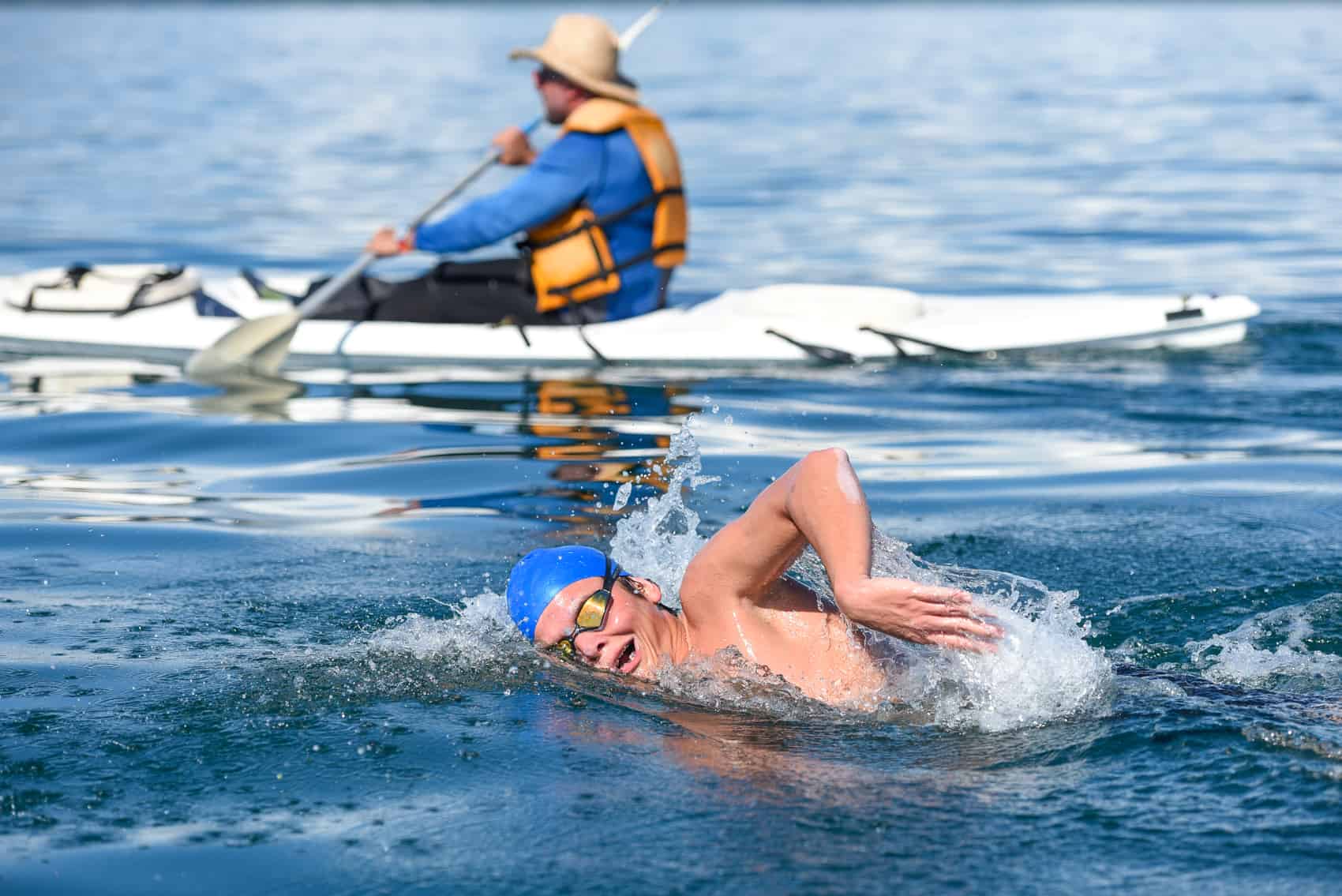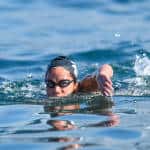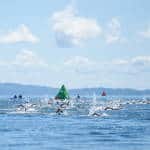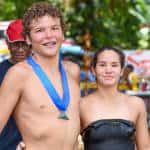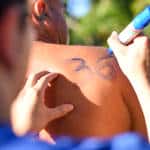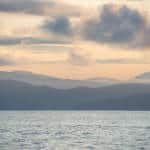PUERTO JIMÉNEZ, Puntarenas — An orange light breaks over the outlines of compressed mountains and sharp palm leaves, ushering in the morning with a stubborn arrival that can’t be delayed by the cloud cover hanging above the bay. The water, once shadowed under twilight, now radiates as it holds the sun’s early reflection.
From the isolated Nicuesa beach, near Golfito on Costa Rica’s southern end, a family of macaws shrieks as their long-red tails glide through towering trees. The birds’ cries crack open the 7 a.m. tranquility, and are immediately followed by the splashes of 30 swimmers entering the waters for the first-ever organized race traversing the length of Golfo Dulce.
On Sunday, open-water swimmers raced in the 14-kilometer route that cuts through the belly of the gulf and can take competitive swimmers as long as six hours. It is a full work day spent churning arms and kicking legs while jellyfish sting every part of the body, and the relentless current works to carry swimmers south. Underneath the surface, the gulf’s active waters stir with whales, dolphins and sharks, bringing the playing field alive in a way no other sport has.
‘Perfect form’
The Cruce Golfo Dulce, the fifth and final leg of Costa Rica’s open-water swim season and also part of the World Open Water Swimming Series, attracted some of the nation’s most talented swimmers to the Osa Peninsula. Christoper Lanuza Segura, a 19-year-old whose broad torso contradicts his boyish curls and baby face, is the No. 1-ranked long-distance swimmer in the country. Like a machine set to one default mode, Lanuza remained in a constant pace that seemed to keep him unaffected by the current, using his wide shoulders to pierce through the water as straight and flawless as a needle through cloth. He took an early lead within the first 30 minutes of the competition and never let it go, as halfway through the race he was already a few kilometers ahead of the next fastest swimmer.
“Look at the way he swims,” said event producer Sergio Sánchez standing on the side of a patrol boat that temporarily waded alongside Lanuza. “His shoulders are completely parallel, exactly the way they should be. It’s perfect form.”
Upon hearing the compliments, Lanuza started to back stroke through the waters with his arms shooting up in the flashy way that synchronized swimmers do. But by that point, the champion, who finished with a staggering time of 2:57:57, had no equal in the waters with whom to hold a routine.
Second-place finisher Angélica Astorga of Cartago reached the sand 15 minutes later, one day after winning the 5-km race. After she got out of the sea, the 18-year-old said jellyfish had been stinging her legs, chest, and face through the first few kilometers.
“That was the hardest part mentally, because there’s 14 kilometers, and I was thinking I can’t put up with this the whole way when getting stung like this,” she said. “But luckily it was just the beginning and afterwards it went back to being calm.”
All but one of the 30 competitors finished the grueling race, which becomes just as challenging on the mind as it does on the body. Somewhat ironically, the only swimmer not to finish was José Manuel Cullel, who became the first known person to swim across Golfo Dulce in July.
Cullel crossed the gulf to test the waters in anticipation of the newest race on the circuit. Event organizer Joe Bernini, who helped coordinate Cullel’s historic swim, added the 14-km race to this third edition of the annual Cruce Golfo Dulce to help the event grow and give back to the area. Proceeds from the race went towards a program that teaches English to local school children so they can boost their chances of getting jobs in tourism.
Bernini, who runs open-water swims and adventure sport events across Costa Rica, said that sports that work in harmony with the environment also help to boost a location’s economy.
“This helps the coastal towns in the low season because when May comes, all of a sudden there’s nobody,” he said. “But for the adventure sports we host, usually it’s best, for example, to do mountain biking in May, or open-water swimming in September, when it’s whale season.”
Motivation
At the Corcovado Beach Lodge located next to the water in Puerto Jiménez, occupancy was full for the entire weekend. Co-owner Tomás McGuinness, who was born in Golfito, said the hotel that can keep up to 50 guests was going to return to being empty after the swimmers, event staff, and press members who stayed there for the weekend returned home.
And for a place where McGuinness has locals coming to ask him every day if he has jobs available at the hotel, new sources for money are sorely needed. He said for the next open-water event in 2016 he expects to hire more people and have different services available, such as a $15 shuttle that picks passengers up from San José.
“The short-term effect this event has is seen in the jobs it creates,” he said. “I’m able to hire three cooks, two gardeners, and hopefully some more. I’m not really out to help myself with this, because this is a business after all, but to give back to the locals.”
From his table at Il Giardino restaurant where he went with friends for three nights in a row, Sánchez said it’s clear to see how adventure sporting events like the Cruce Golfo Dulce can put money that wasn’t there before into a coastal town’s restaurants and hotels.
“Through the sport, we’re encouraging local and international tourism and we’re able to positively impact the place in terms of the environment, the economy, and the culture,” Sánchez said. “It makes the community happy and motivates them to keep things clean and sustainable.”
The coveted Blue Flag for Cruce Golfo Dulce
During the weekend, photos of trash and throwaway plastic covering the streets of Guanacaste following the Tamarindo Beach Marathon went viral on Costa Rican social media groups. Officials from the Costa Rican Oceanology Institute took to Facebook to criticize the lack of action from the marathon’s organizers after the streets were left buried in trash late into the afternoon Saturday.
Hundreds of bags filled with drinking water lined the streets in a province currently facing one of the worst droughts in its history.
Maríe Cécile Beal, who founded the nongovernmental organization, said members of her group had to make multiple calls to marathon organizers and community members to get the streets cleaned up. “What makes us most upset is that they threw these bags full of drinking water, and right now there are communities in the region that don’t have water,” she told the daily La Nación on Saturday. “It’s disrespectful to the people there.”
While all of these events gained significant media attention in one of the country’s most popular beaches, on the opposite end of the country in the secluded Puerto Jiménez, a flag was being lifted to credit the Cruce Golfo Dulce as an environmentally beneficial event. The government’s Ecological Blue Flag program runs through a strict series of guidelines that seeks to honor certain places and events that conserve and protect natural resources.
Throughout the weekend, event organizers worked with a local organization that helped sort out labeled recycling bins and kept the beach clean. Sánchez said aside from the positive impact on an important ecosystem that in August and September reaches peak season for whales and dolphins, the ultimate goal was to increase social and environmental awareness in a coastal community that needs every drop of revenue it can get.
“This event couldn’t be anymore sustainable,” Sánchez said. “It’s a model for events outside of San José and for how they should look so that the community grows and the community gets involved. It’s an organic event and you can see in other places, like in Tamarindo, it’s been complicated because the events grew so fast that right now they can’t coordinate as well with the community.”
But attracting people to an area as remote as the Osa Peninsula, which requires either a six-hour drive from the capital or a relatively expensive plane ride, could be a tricky proposition even with an annual event like the Cruce Golfo Dulce, which is bound to grow in the coming years. Also, much of the area remains an unknown to many Costa Ricans. McGuinness, who lived in Los Angeles, California, for five years, said people from outside of Costa Rica are sometimes more likely to recognize what Corcovado National Park is then those who live in the country.
Looking out to the beach in front of his hotel property, McGuinness said he returned home to eventually retire and live out the rest of his life in the setting he repeatedly calls pristine.
“This is the place where you come to live, not survive,” he said. “Survive you can do anywhere. Here is where you feel alive.”
The bay, which is known for its incredible diversity of fish species, is spotted with crocodile-filled mangroves on the southwest end as the peninsula rounds towards Corcovado, the public reserve regularly noted for its wide range of animals and plants. It’s hard to imagine a setting anymore fitting to tie a sport to nature as with Golfo Dulce and open water swimming.
Maybe that’s why the under-the-radar event is already getting excellent feedback from community members and participants. Each of the 30 swimmers who competed this year told organizers that they would return in 2016 to race, Bernini said.
Through the annual crossing of Golfo Dulce, Sánchez said, there’s a booming potential to highlight one of Costa Rica’s most precious natural jewels.
“If we were in another country this wouldn’t necessarily be happening,” he said. “But we’re in Costa Rica and we have to use this tool. We want to develop awareness in the places we go and this is the way we know how.”

